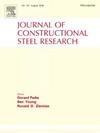Flexural behavior of cold-formed steel I-beams strengthened in the web with different materials
IF 4
2区 工程技术
Q1 CONSTRUCTION & BUILDING TECHNOLOGY
引用次数: 0
Abstract
This research presents an experimental and theoretical study investigating the flexural capacity of built-up steel cold-formed I-beams strengthened in the hollow web with different materials. Eight built-up cold-formed steel I-beams were prepared and experimentally tested. As a control specimen, one was not strengthened, steel shear connectors strengthened one without materials, and six specimens were strengthened by filling the hollow web with different materials. The strengthened materials used are wood wastes (Sawdust with epoxy- Sawdust with polyester), lightweight concrete, normal-weight concrete, High-Strength concrete, and polymer mortar. The specimens' method of failure, load at failure, and vertical displacements were recorded. The relationship between vertical load and deflection at the span's midpoint has been graphed to analyze the impact of strengthened materials. Using polymer mortar resulted in the highest capacity, outperforming other materials. Finite element models of the tested beams were established. Good agreements between experimental and numerical models were observed. 84-FE numerical models were established to determine the effect of cover plate thickness on flange width ratios and the height-to-width of the strengthening material. Finally, new equations that calculate strengthened beam capacity were presented.
采用不同材料加固腹板的冷弯型钢工字钢的抗弯性能
本研究通过实验和理论研究,探讨了用不同材料加固空腹结构的内置冷弯型钢工字钢的抗弯能力。研究人员制备了八根内置冷弯型钢工字钢,并对其进行了实验测试。其中一个试样作为对照试样未进行加固,一个试样在未使用材料的情况下使用钢制剪力连接件进行加固,六个试样通过在空腹腹板中填充不同材料进行加固。使用的加固材料包括木屑(环氧树脂锯屑-聚酯锯屑)、轻质混凝土、普通混凝土、高强度混凝土和聚合物砂浆。记录了试样的破坏方式、破坏时的荷载和垂直位移。跨度中点的垂直荷载和挠度之间的关系被绘制成图表,以分析加固材料的影响。使用聚合物砂浆的承载力最高,优于其他材料。建立了测试梁的有限元模型。实验和数值模型之间的一致性良好。建立了 84-FE 数值模型,以确定盖板厚度对翼缘宽度比和加固材料高宽比的影响。最后,提出了计算加固梁承载力的新方程。
本文章由计算机程序翻译,如有差异,请以英文原文为准。
求助全文
约1分钟内获得全文
求助全文
来源期刊

Journal of Constructional Steel Research
工程技术-工程:土木
CiteScore
7.90
自引率
19.50%
发文量
550
审稿时长
46 days
期刊介绍:
The Journal of Constructional Steel Research provides an international forum for the presentation and discussion of the latest developments in structural steel research and their applications. It is aimed not only at researchers but also at those likely to be most affected by research results, i.e. designers and fabricators. Original papers of a high standard dealing with all aspects of steel research including theoretical and experimental research on elements, assemblages, connection and material properties are considered for publication.
 求助内容:
求助内容: 应助结果提醒方式:
应助结果提醒方式:


